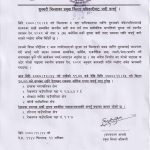LOWER PRODUCTIVITY OF MAIZE IN NEPAL AND ITS PROBLEM SOLVING PROCESSES

Introduction
Scientific Name: Zea mays
Maize belongs to the Graminae family. It is the third important cereal crop in the world and ranked second position as the second important staple crop in Nepal in terms of area(850947ha) and production(1734417 tons) with the productivity of 2.03 tons/ha (CBS, 2006). It is a traditional crop grown for food, feed and fodder. In Nepal, maize flour is mainly used for making Roti (bread) and Dhindo (pudding) while grains are topped and green cobs are roasted for table purpose. Maize can be grown in all kinds of agro-ecological zones irrespective of land type and seasons. Due to heterogenous gene accumulation in this crop, it is widely adaptable to different stress environment and is widely grown from the terai to high mountains in Nepal where it is considered a major food crop and its importance increases with increasing altitude. Maize is the main crop in hilly areas where it is rainfed crop in Bari condition. It is staple crop of the hilly region, which occupies about 80% of the total maize area and contributes more than 75% to the total production in the country.
Maize protein “Zein” is deficient in Tryptophane and Lysine, the two essential amino acids. Maize grain has significant quantities of Vitamin A, nicotinic acid, riboflavin and Vitamin E. Green fodder is used as fodder for cattle and several industries like starch, miling, and cottage industries are based on maize products and byproducts.
Maize Statistics: area, production productivity
In 2005, maize was grown in 849892 ha of land and 1716042 mt of maize grain was produced and in 2014 the area and production was increased by 78869 ha and 567180 mt respectively (MOAD, 2014). The increased in maize productivity during the past decade (2005 to 2014) was only 0.439 mt/ha. The yield increment at every five years period since 1970 to 2010 varied from negative (-9.71%) in 1975-1979 to 7.76% in 2011-2014. The present yield level is quite low to fulfill the country’s demand. Therefore, there is a big yield gap of maize in Nepal as affected by various technological and socio-economical factors.
Lower productivity of maize in Nepal
Being the second important staple food crop of Nepal and emerging as an industrial crop in accessible areas of Nepal, as a corn oil, animal feed ingredients, glucose, corn flakes, etc. The farmers changing their cropping pattern by including vegetable and other cash crops in their rotation system in response to market forces and also to meet their cash demand. But the productivity of maize in Nepal has dropped by more than 17% since the mid seventies affecting hills the most. The area, production and productivity has marginally improved over the last 25 years in terai where as mid and high hills area under maize has increased by 20% but productivity has declined by 17%. This might br resulted due to the following reasons.
1. Smut and turcicum blight in the eastern and midwestern/ far-western midhills and highhills; ear rot in the central/western and mid-western/far-western midhills; stalk rot in the mid-western/far-western midhills, terai, and highhills; and downy mildew and leaf firing in the terai were important diseases mentioned by farmers. Weevils and Angoumois grain moth were major problems in stored grain throughout the country.
2. Among important recent changes are a reduction in livestock numbers, forest degradation, and reduced availability of labor, development of community forest and stall-feeding of cattle led to reduction in amount of manure. The reasons for low use of chemical fertilizer included high cost, non-availability at key times and a lack of knowledge of their use. There are no updated recommendation on the doses of fertilizer for high yielding hybrids, winter, spring and summer season, rainfed and irrigated maize.
3. One factor that contributes to low system productivity is faulty thinning practices that lead to sub-optimal plant populations at harvest. However, information on optimal plant populations is lacking for maize-millet systems in Nepal.
4. Research efforts in the past concentrated mainly on accessible areas of Terai, which occupies only 20% of total maize area.
5.Decline soil fertility in rainfed marginal hill land, which occupies 80% area , and unavailability of production inputs possess a serious threat for higher sustainable development.
6. In Hills, maize production is a part of complex system with extreme environmental variability and hence needs a system -based approach , which has been neglected in the past. There is wide gap between potential yield of open pollinated varieties (OPVs) having 5.0 tons/ha (on experimental yields), attainable yield of about 3.5 tons/ha (on farm yield improved practices) and actual yield of 1.87 tons/ha (2002/03).
7. Nearly 90% of maize area that are planted in spring season (mainly khet land) faces severe drought as flowering in 3 years out of 5 years (RRA, Survey Report, 1994) it may be one of the major problem of Nepal.
8. A rapid decline in soil physical and chemical properties, low organic matter content, nutrient deficiencies, soil acidity are major production constraints in general terai but in particular hills.
9. Ineffective and inadequate input and credit supply and organized marketing facility are also other reasons to decrease productivity of maize in Nepal.
10. High temperature in spring season sown maize cause total failure of maize crop. Hailstorm and erratic rains also causes occasional problems.
11. Lack of suitable production domains specific,open pollinated varieties for hills and hybrids for terai, due to which improved varieties of maize and their seed purity have not been maintained easily.
In order to address the aforementioned problems the following actions need to be taken:
1. These below mentioned varieties would be helpful in increasing the productivity of maize.
Production domain Recommended varieties
High hills (>1500 m. asl): Ganesh-1 and Ganesh-2
Mid hills (>1000 m. asl): ankamana-1, 2,3,4, and 6, Deuti, Sitala, Khumal, Hybrid 2
Foot hills (Spring maize): Rampur composite, Arun-1, Arun-2, Arun-3 and Arun-4
Terai/foot hills: Rampur composite
Terai (Winter maize): Rampur hybrid-2 and Rampur composite
Promising NMRP hybrids: RML-32/RML-17, RML-4/RMl-17, RML-86/RML-96, RML-95/RML-96
2. No tillage with retention of previous crop residue i.e. conservation tillage (CT) under rice-maize system found superior in terms of grain yields of respective crops and their system yields, soil nutrient status (soil organic matter, nitrogen, phosphorus and potassium), cost of cultivation and hence net return, and non-lodging plants over the farmer’s tillage practice of conventional tillage without the crop residue (FP).Conservation tillage in maize reduced the impact of drought by lowering soil temperature and surface evaporation, hence increased grain yield.
3. Maize grains treated with 5% dust of malathion and 2-3 tables of Aluminium phosphide (Celphos) per metric ton found effective to protect against storage pests. In the case of botanicals, Bojho (20 gm/Kg seed) found effective control to maize weevil, where the infestation was only 2.25% during the period of nine months of storage. Furthermore, Neem kernel seed powder @10 g/kg and timur @4g/kg of maize grain and Super grain bag® was found free from storage insect pests up to 6 months.
4. To date general recommendation of fertilizer for maize in Nepal is 120:60:40 NP2O5K2O kg /ha. For spring and summer season maize the recommended doses of Nitrogenous fertilizer can be applied in splits i.e at 30, 45 and 60 days after seeding for the higher grain yield.
5. To alleviate the constraints of maize production, both varietal development and crop management research need to be implemented in an integrated approach. There is a need for location-specific maize production technologies, especially for lowland winter maize, marginal upland maize production system, and resource poor farmers. Research efforts can be targeted to address both yield potential and on-farm yields by reducing the impacts of abiotic and biotic constraints.
6. Application of modern tools of breeding like Marker-Assisted and Genomics for the fast track and precision breeding program in collaboration with CIMMYT and other concerned organizations.
7. Development of stress (drought, heat, cold , low nutrient and high density ) resilient high yielding hybrids and open pollinated varieties of maize for different production ecologies.
In a nutshell, the conventional maize production system needs to be converted into modern, resource use efficient and climate smart under the pretext of stagnant productivity as a result of limited area expansion, low yield potential of the existing genotypes, imported hybrid seed, declining soil fertility, and emergence of new pest species, labor and water.Therefore, the research should focus on utilizing the latest tools of plant breeding for the development of stress resilient maize genotypes, hybrid seed production effort, climate smart, and resource conserving agro-techniques like conservation agriculture.
Writer: Kriti Bhattarai (Student, Bsc. Ag IAAS Paklihawa Campus)

 एउटा यस्तो विषालु भ्यागुता, जसको मुल्य नै पर्छ ३ लाख, जान्नुहाेस्
एउटा यस्तो विषालु भ्यागुता, जसको मुल्य नै पर्छ ३ लाख, जान्नुहाेस्  भोलि र पर्सि बालबालिकालाई भिटामिन ए खुवाइदै
भोलि र पर्सि बालबालिकालाई भिटामिन ए खुवाइदै  खगराज अधिकारी गण्डकीको मुख्यमन्त्री नियुक्त
खगराज अधिकारी गण्डकीको मुख्यमन्त्री नियुक्त  सुनसरीमा दुवै पक्षबीच सहमति, कर्फ्यु खुकुलो हुदै
सुनसरीमा दुवै पक्षबीच सहमति, कर्फ्यु खुकुलो हुदै  स्टेफेनको शतकमा आयरल्याण्ड वोल्भ्सले नेपाल ए लाई दियो २८५ रनको लक्ष्य
स्टेफेनको शतकमा आयरल्याण्ड वोल्भ्सले नेपाल ए लाई दियो २८५ रनको लक्ष्य 


